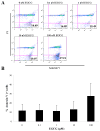Preclinical development of the green tea catechin, epigallocatechin gallate, as an HIV-1 therapy
- PMID: 19203663
- PMCID: PMC2665796
- DOI: 10.1016/j.jaci.2008.12.024
Preclinical development of the green tea catechin, epigallocatechin gallate, as an HIV-1 therapy
Abstract
Background: Previously, we presented evidence that at physiologic concentrations the green tea catechin, epigallocatechin gallate (EGCG), inhibited attachment of HIV-1 glycoprotein 120 to the CD4 molecule on T cells, but the downstream effects of EGCG on HIV-1 infectivity were not determined.
Objective: To evaluate the inhibition of HIV-1 infectivity by EGCG and begin preclinical development of EGCG as a possible therapy.
Methods: PBMCs, CD4(+) T cells, and macrophages were isolated from blood of HIV-1-uninfected donors. HIV-1 infectivity was assessed by an HIV-1 p24 ELISA. Cell survival was assessed by cell viability by Trypan blue exclusion assay, cell growth by thymidine incorporation, and apoptosis by flow-cytometric analysis of annexin-V binding.
Results: Epigallocatechin gallate inhibited HIV-1 infectivity on human CD4(+) T cells and macrophages in a dose-dependent manner. At a physiologic concentration of 6 mumol/L, EGCG significantly inhibited HIV-1 p24 antigen production across a broad spectrum of both HIV-1 clinical isolates and laboratory-adapted subtypes (B [P < .001], C, D, and G [P < .01]). The specificity of the EGCG-induced inhibition was substantiated by the failure of EGCG derivatives lacking galloyl and/or pyrogallol side groups to alter HIV-1 p24 levels. EGCG-induced inhibition of HV-1 infectivity was not a result of cytotoxicity, cell growth inhibition, or apoptosis.
Conclusion: We conclude that by preventing the attachment of HIV-1-glycoprotein 120 to the CD4 molecule, EGCG inhibits HIV-1 infectivity. Because this inhibition can be achieved at physiologic concentrations, the natural anti-HIV agent EGCG is a candidate as an alternative therapy in HIV-1 therapy.
Figures




Similar articles
-
Epigallocatechin gallate, the main polyphenol in green tea, binds to the T-cell receptor, CD4: Potential for HIV-1 therapy.J Allergy Clin Immunol. 2006 Dec;118(6):1369-74. doi: 10.1016/j.jaci.2006.08.016. Epub 2006 Oct 13. J Allergy Clin Immunol. 2006. PMID: 17157668
-
Green tea catechin, epigallocatechin-3-gallate (EGCG): mechanisms, perspectives and clinical applications.Biochem Pharmacol. 2011 Dec 15;82(12):1807-21. doi: 10.1016/j.bcp.2011.07.093. Epub 2011 Jul 30. Biochem Pharmacol. 2011. PMID: 21827739 Free PMC article. Review.
-
Epigallocatechin-3-gallate regulates cell growth, cell cycle and phosphorylated nuclear factor-κB in human dermal fibroblasts.Acta Pharmacol Sin. 2011 May;32(5):637-46. doi: 10.1038/aps.2011.17. Epub 2011 Apr 25. Acta Pharmacol Sin. 2011. PMID: 21516136 Free PMC article.
-
How can (-)-epigallocatechin gallate from green tea prevent HIV-1 infection? Mechanistic insights from computational modeling and the implication for rational design of anti-HIV-1 entry inhibitors.J Phys Chem B. 2006 Feb 16;110(6):2910-7. doi: 10.1021/jp0550762. J Phys Chem B. 2006. PMID: 16471901
-
Green tea polyphenol epigallocatechin 3-gallate in arthritis: progress and promise.Arthritis Res Ther. 2010;12(2):208. doi: 10.1186/ar2982. Epub 2010 Apr 28. Arthritis Res Ther. 2010. PMID: 20447316 Free PMC article. Review.
Cited by
-
Respiratory protease/antiprotease balance determines susceptibility to viral infection and can be modified by nutritional antioxidants.Am J Physiol Lung Cell Mol Physiol. 2015 Jun 15;308(12):L1189-201. doi: 10.1152/ajplung.00028.2015. Epub 2015 Apr 17. Am J Physiol Lung Cell Mol Physiol. 2015. PMID: 25888573 Free PMC article. Review.
-
In-silico drug repurposing for targeting SARS-CoV-2 main protease (Mpro).J Biomol Struct Dyn. 2022 Apr;40(7):3003-3010. doi: 10.1080/07391102.2020.1844058. Epub 2020 Nov 12. J Biomol Struct Dyn. 2022. PMID: 33179568 Free PMC article.
-
Therapeutic Modulation of Virus-Induced Oxidative Stress via the Nrf2-Dependent Antioxidative Pathway.Oxid Med Cell Longev. 2018 Oct 31;2018:6208067. doi: 10.1155/2018/6208067. eCollection 2018. Oxid Med Cell Longev. 2018. PMID: 30515256 Free PMC article. Review.
-
Development of Small-Molecule Inhibitors Against Zika Virus Infection.Front Microbiol. 2019 Dec 6;10:2725. doi: 10.3389/fmicb.2019.02725. eCollection 2019. Front Microbiol. 2019. PMID: 31866959 Free PMC article. Review.
-
A non-targeted approach to chemical discrimination between green tea dietary supplements and green tea leaves by HPLC/MS.J AOAC Int. 2011 Mar-Apr;94(2):487-97. J AOAC Int. 2011. PMID: 21563682 Free PMC article.
References
-
- Wang R, Gu Q, Wang Y, Zhang X, Yang L, zhou J, et al. Anti-HIV-1 activities of compounds isolated from the medicinal plant Rhus chinensis. Journal of Ethnopharmacology. 2008;117(2):249–56. - PubMed
-
- Wu J, Wang X, Yi Y, Lee K. Anti-AIDS agents 54. A potent anti-HIV chalcone and flavonoids from genus Desmos. Bioorg Med Chem Lett. 2003a;13:1813–5. - PubMed
Publication types
MeSH terms
Substances
Grants and funding
LinkOut - more resources
Full Text Sources
Other Literature Sources
Medical
Research Materials

